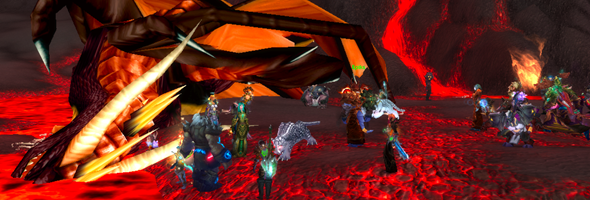
The following is a guest post by Briolante, one of Conquest’s main tanks, also sometimes known as Mr. Sydera. Brio is normally a man (ahem, night elf) of few words, but here he waxes poetic on what it means to be leet. We’ve all wondered this, right, as we struggle to define what makes a good player both for ourselves and for our guilds. Enjoy!
Montaigne’s meditation on glory states: “there is the name and the thing.” The same could be said about leetness, which is what passes for glory in the World of Warcraft. We all know the name. We all sometimes sprinkle the word in our conversations and boasting. We may even think we know what the thing is that our words refer to. However, we’re usually wrong. After a ridiculous night of stupid trash mishaps in Naxx, I heard that word thrown about in a context that puzzled me, and I began to wonder what it really means to be an elite player.
Leet or sloppy?
Any raiding team has had off nights, nights where the focus, drive, and attention to detail just aren’t there. Sometimes we even intentionally (gasp) horse around to have a little fun when the content is as stale as the current raid content has become for many of us. The other night in Naxx, we had all manner of bedlam happening around us. Tanks weren’t paying attention to patrols and pulling extra mobs, DPS was opening up AOE before the tanks had even arrived at the scene, and on and on. And guess which green-haired night elf was up there helping cause the problems? Yeah, that was me. Who was left to sort out this mess? The healers, of course, who were usually able to keep enough of us up to get through the pull. It was after pulls like this that some of us bandied about the world leet. But, is this really leet? No, it’s sloppy, it’s lol-1337. But sometimes players fall into the trap of thinking they’re so good that being able to survive the biggest SNAFU confirms the group’s collective leetness.
Early in the Wrath leveling process, I pugged a Nexus run with a group made up of four other players from a guild whose name I have since forgotten. When the priest and druid couldn’t figure out who was going to heal, I started to worry. When two of them decided they were going to jump off the platforms and die below for shits and giggles, I knew it was going to be a long evening. Over the course of our 2.5 hours together (yes I stayed), each one of them committed suicide at least 4 separate times. When we were actually fighting mobs, they died constantly because they weren’t paying attention. Most of the boss kills were lol-kills with one or no players left alive at the end. Any of my guildies who were on that night will remember how pissed off I was in guild chat. I’m usually pretty Zen in my virtual life, but those two just made me lose it. But do you know what? The members of this other guild I was playing with were proud that they could always pull it out, no matter how sloppy. They even described this as their guild ethos. This style of play, in their mind, confirmed their leetness. I could not disagree more.
Leetness is a state of mind
What might the thing called leetness be then? In my mind, the best example of leetness would be the old ZA bear run. Depending on your gear level, earning a bear required near perfect execution and play. Each player had to know every pull and what his/her role in those pulls was. Of course, as we got better, people could make mistakes and we could adjust. But in the early days, it really required minimal mishaps. Is that leetness? I can say that for me, nothing was more pleasurable from a raid leading perspective than those bear runs. When everyone comes together, experiences the synergy, and executes an encounter well, it feels good and everyone knows it.
I might say then that leetness is a state of mind and a precision of execution. In raiding anyway, this is not something that just one person can have, because the whole team has to be there mentally. Conquest’s recent three-drake kill is proof that we have the potential for that state of mind and that precision of execution. But have we suddenly become “leet”?
The importance of execution
One of my biggest disappointments in my former guild from a raid management and leadership perspective was that we only managed to get Illidan down once before the pre-Wrath nerf. The intial kill wasn’t the prettiest thing in the world, but he was definitely defeated. In the few weeks after that kill, we were never able to get it down again. We got close, but never quite hit that same focus and precision again. It was as if we had accomplished something once and that was enough. People just didn’t care anymore. I asked myself, had we really proved our leetness once and for all by defeating Illidan?
The answer to both of those questions, I would argue, is no. Execution is important at every stage of the game, on progression and farm content alike. Leetness is not something that can be earned definitively. It’s not something that can be possessed, like the many titles that now commodify it for all to see. Leetness is something that we demonstrate, each time we raid. It’s a state of mind and play that we arrive at together, maybe not all the time, but most of the time. It’s our intention, our goal.
Leetness and teamwork
So Brio, you might ask, I top the dps/healing/threat charts. My dps is world ranked! Am I not leet? My answer would be no. From a raiding perspective, leetness is not something that just one person can earn. Raiding is about team play, period. While worrying about topping the meters or beating someone else in your class can sometimes force you to improve yourself, taken to extremes it becomes a hollow form of narcissism. Yes, you topped the meter, but did you get out of the fire? Or, on the contrary, did you overtax the healers who needed to be focusing on the tank? Yes, you topped the healing meter, but did you do your job and do it to the best of your ability? Did you try to “cover” for other people in order to eke out more effective heals? Yes, you did 3000 tps, but did you properly manage your buffs/debuffs in order to make yourself as easy to heal as possible?
As I see it, excellence in raiding difficult content cannot be about egos and winning personal performance meters. You have to do your job first and foremost. On three-drake Sarth, some players didn’t get the message until we obsessively repeated that a player’s first priority is to get out of the void zones. The second priority is to not get hit by the fire walls. The third priority is to dps/heal/etc. As one of the officers in my former guild liked to say, the dead don’t dps.
Raiding is about synergy and teamwork. Difficult content demands it. Difficult content cannot be completed without it. When the desire is there, when the focus is there, when the precise execution is there, when everyone does his/her job, the kill is, quite simply, beautiful. A well-executed kill is breathtaking to watch and experience. This is why sometimes the leet kill isn’t necessarily the first one, but rather the one where the kill looks effortless, like simplicity itself. We’ve all felt this, whether in 5-man dungeons or in 25-man hard mode raids. When Conquest finally downed Sarth 3D after many wipes, we found this state of mind and executed the fight almost flawlessly. Does that mean we’re now leet?
No. Leetness is not something you earn once and for all. It’s something that you work for, every raid, week in, and week out. It starts with desire and then requires the trust that the rest of your team is there to do the same thing.
Can we be leet in the current content?
Naxx is ridiculously easy. You don’t need to mark, you don’t need to CC, and yes, you can slop your way through there, survive, and still get it all done in under three hours. But that’s not leet, that’s lol-1337. Running in with an immediate seed, blade flurry, arcane explosion, hurricane, whirlwind, or whatever and pulling everything on yourself and the healers is not leet, it’s lol-1337. Pulling 18 mobs at once, allowing 10 players to die, and still managing to kill them all is not leet, it’s lol-1337 (and yes, that one was my fault–sorry).
Playing sloppy can be fun, loose, relaxed. Sometimes it’s just what the doctor ordered after some really hard work on a difficult encounter. Even I can’t help myself from laughing when a hunter misdirects the next pull onto the resto shammy. But make no mistake, that’s not leet, that’s Leroy Jenkins.
Leetness is focus, precision, synergy, teamwork, execution, and above all else, control. It’s an individual and collective intention, something that we arrive at together with varying degrees of frequency. Due to the easiness of the current content, we’ve forgotten what some of those things are. Let me ask a scandalous question – do our dps players even have their crowd control abilities on the main bars anymore? This is symptomatic of the problem. But if all blue indications hold true, Ulduar will be a different story. Thank heavens, because I was getting frustrated with just how forgiving many of these encounters are, including the trash. I raid for the challenge and for the beauty that results when a team of players meets that challenge with precision. Does that turn the beautiful, effortless kill into a work of art? Maybe, but perhaps that should be the subject for another post.
To return to the matter at hand, dear readers, after this long rant, do you still think you’re so leet? Then show your guild mates how truly leet you are by executing every fight like you mean it.




